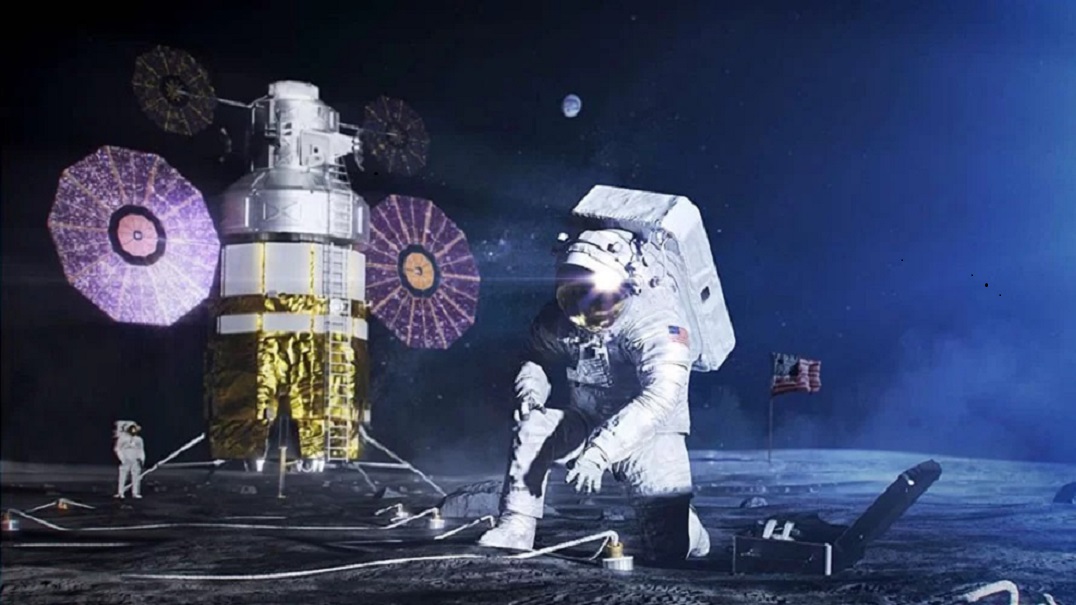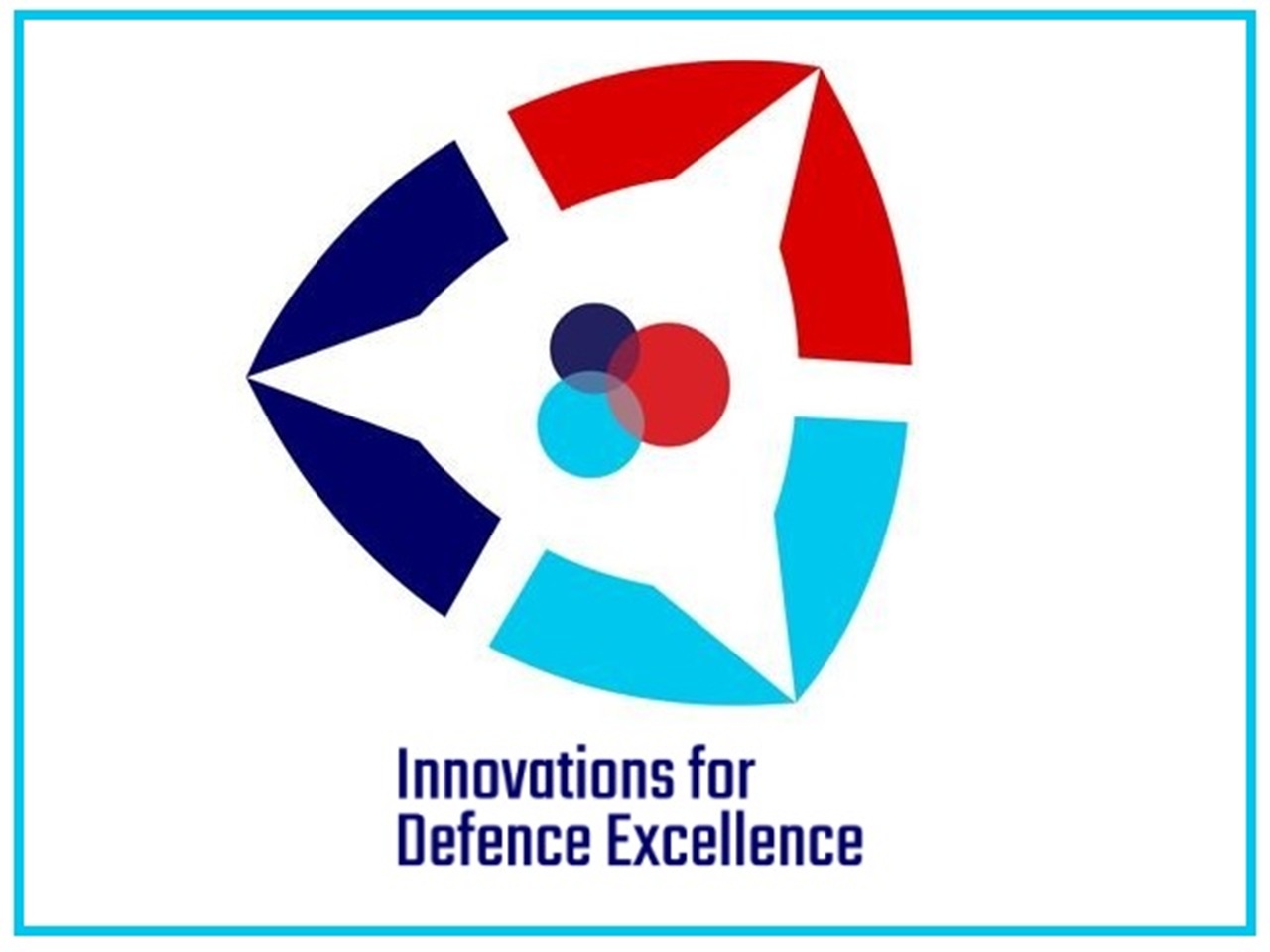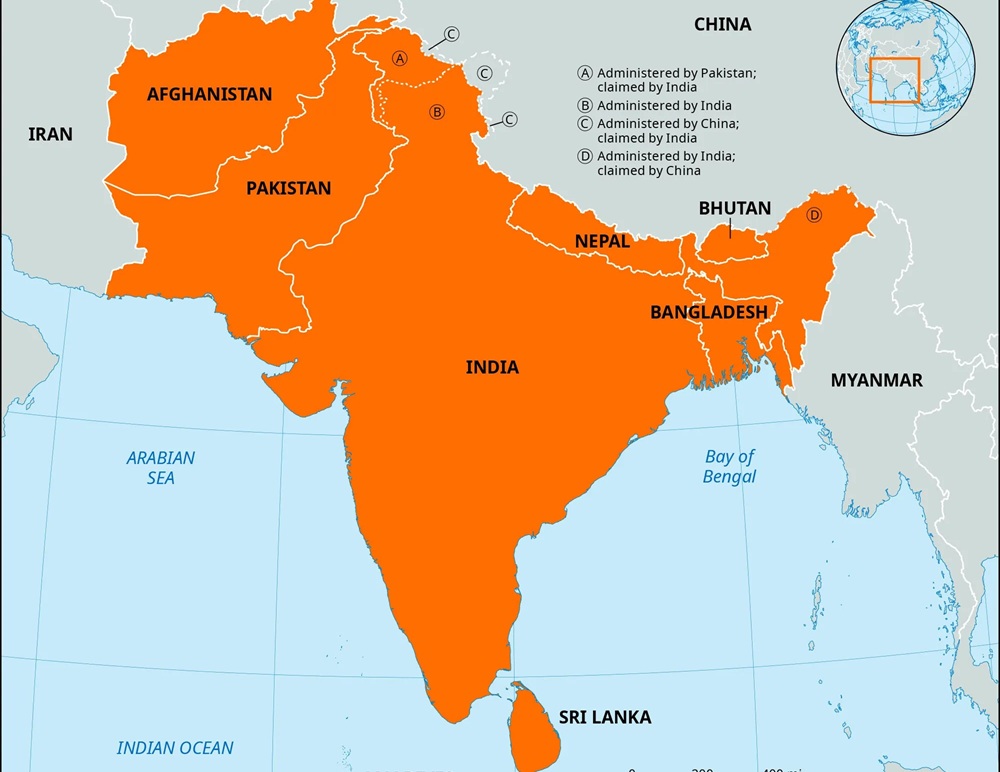Chandrayaan-3 is scheduled to be launched on July 14, 2023, at 2: 35 pm from the Satish Dhawan Space Centre of ISRO in Sriharikota.
The propulsion module of Chandrayan 3 will carry the rover and lander with payloads to study the spectral and polarimetric measurements of Earth from the lunar orbit, instruments to measure the thermal conductivity, temperature and seismicity around the landing site and a Langmuir Probe to estimate the plasma density and its variations. A passive Laser Retroreflector Array from NASA is also accommodated for lunar laser ranging studies. Rover has even a payload to derive the elemental composition in the vicinity of the landing site.
During the recent visit of the Prime Minister of India to the US, an agreement was signed for a partnership between NASA and ISRO. Besides this agreement, India has also signed the Artemis Accord with the US which has a signatory of 27 Nations. This initiative is to integrate ISRO with the leading space agencies in the world so that ISRO can accelerate their space exploration programs including Chandrayan and Mangalyan missions in the coming decade.
Artemis Accord
The Artemis Accords were jointly launched by the United States Department of State and NASA on October 13, 2020. The accord establishes a common vision to enhance civil exploration and the use of outer space. The Accord aims to place humans on the moon and to expand space exploration to Mars and beyond. It is intended to increase the safety of operations, reduce uncertainty and promote the peaceful use of space for all humankind. The Accord is a commitment to provide operational implementation of the Outer Space Treaty of 1967 and other similar instruments applicable to all civil space agencies including our ISRO. The mission covers the Moon, Mars, comets, and asteroids, their surfaces and sub-surfaces including the orbits of the Moon or Mars, in the Lagrangian points for the Earth-Moon system and in transit between these celestial bodies and locations.
Accord Framework
The activities associated with Artemis are strictly confined to peaceful purposes and are done in a transparent manner. The accord assures system interoperability by maintaining common standards and emergency intra-support to space programs of all signatories. The accord insists registration of every space object being launched by space agencies of the signatories. The exchange of scientific data generated during space exploration between member nations is one of the major provisions of the accord which would directly benefit the signatory nations. Commitment to uphold outer space heritage, a calibrated exploitation and sharing of resources for sustainable and safe operations make this accord more meaningful. Resolving existing conflicts between space agencies is another mandate of this accord which could minimise disputes between the space agencies. Accord is also destined to minimise and mitigate space debris.
Benefits for India
There are many immediate benefits for India and ISRO by partnering with NASA. We can expect Indian astronauts on board International Space Station (ISS) next year on a joint space mission with NASA in the year 2024. NASA is also going to provide advanced training to Indian astronauts at the Johnson Space Centre in Houston, Texas for future space missions. NASA is also planning to facilitate manned moon missions starting in 2025. Later this program may extend to space exploration starting with Mars and to other celestial destinations in the future. Both ISRO and NASA would enhance commercial collaboration with the private sectors of both countries to strengthen the value chain of the space economy. This would certainly trigger space-oriented startups in the country since the agreement would de-clutch the export controls and facilitate the Transfer of Technology (TOT) in the space segment.
Artemis Programmes
NASA has derived this program’s name from Artemis, the Greek goddess of wild animals, vegetation, chastity and childbirth. Artemis was the daughter of Zeus and Leto and the twin sister of Apollo. Artemis program is a continuation of the Apollo program which was halted after the successful moon mission in 1969.
Artemis 1
NASA successfully launched Artemis 1 on November 16 year 2022 from NASA’s Kennedy Space Center, Florida. This mission was uncrewed to test the Space Launch System (SLS) rocket and the Orion capsule to reach the moon. After taking the lunar orbit it returns to Earth for an ocean splash. The SLS rocket also carried ten CubeSats into space to perform associated experiments. The Orion capsule successfully completed the mission on 11 Dec 2022 after travelling a 2.3 million kilometres flight. Each of the 19 stages of the mission is explained in the figure below.
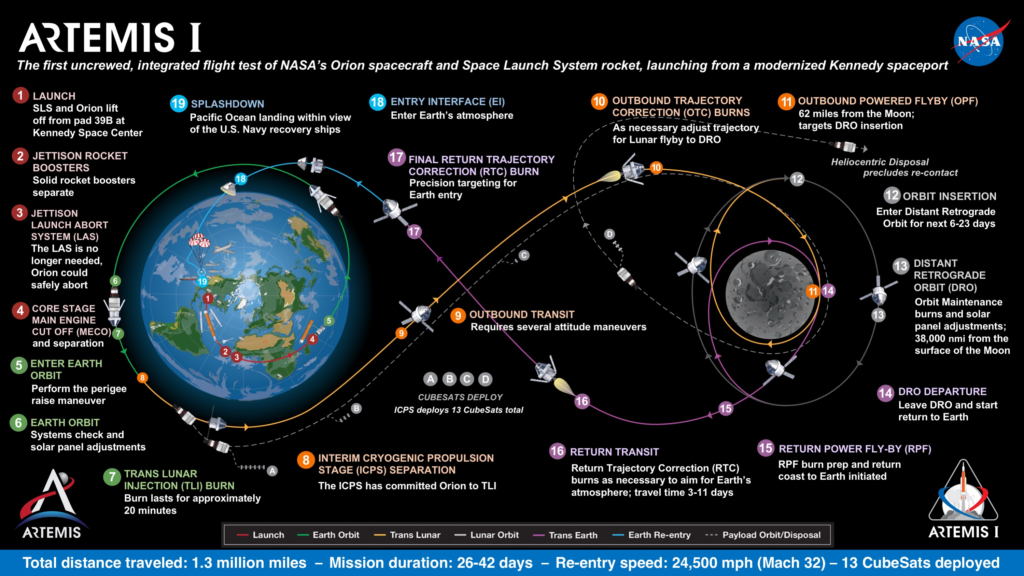
Artemis 2
Scheduled for 2024, will carry the first four Artemis astronauts in the Orion capsule. This capsule will accommodate the crews from Earth for a 10-day mission. The crew will complete the lunar flyby and return back to Earth. During the flight, the crew will evaluate the spacecraft’s systems and equipment. Each stage of this mission is explained in the figure below.
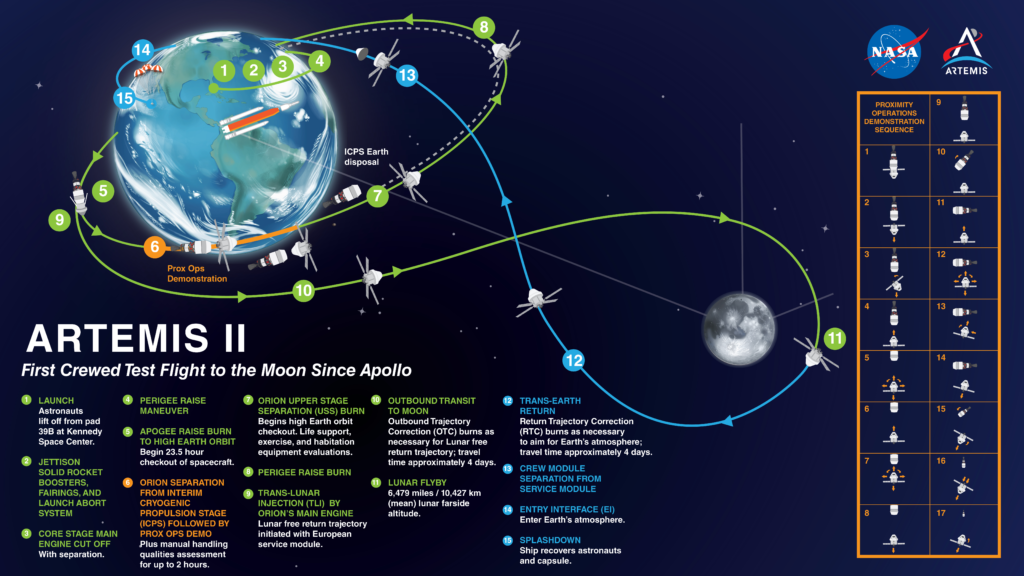
Artemis 3
Scheduled for 2025-2026, this mission will have a combined man and woman astronauts on the lunar surface. This mission is linked to the previous missions and their success. The astronauts will attempt to land on the moon on the lunar lander and two astronauts will remain in the south polar region of the moon for a week duration. Each stage of the mission is shown in the figure below.
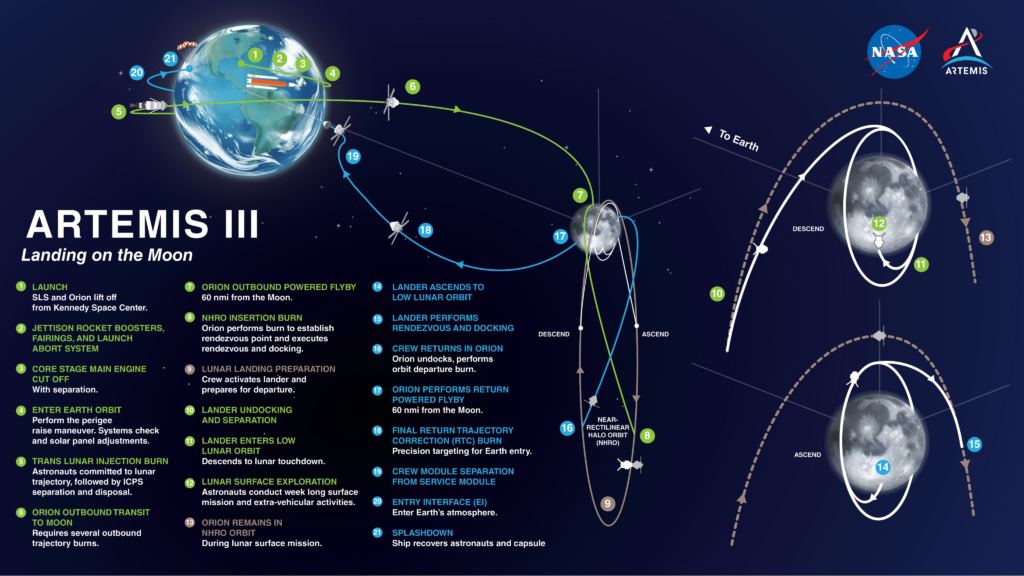
NASA’s “moon to Mars planning manifest” was released with its 2023 budget request suggesting Artemis 4 will launch in 2027 to help build out Gateway. A gateway is a multi-purpose outpost orbiting the Moon that provides essential support for long-term human return to the lunar surface and serves as a staging point for deep space exploration. Then the next human landing on the moon would be Artemis 5 in 2028. The following three landings for Artemis 6 through 8 would happen in 2029, 2030 and 2031.
NASA-ISRO Synthetic Aperture Radar (NISAR)
The partnership between NASA and ISRO started way back in 2014. On Sept. 30, 2014, an agreement was signed to launch NASA-ISRO Synthetic Aperture Radar (NISAR) satellite by the year 2024. This Low Earth Orbit (LEO) satellite is designed to observe and take measurements of some of the planet’s most complex processes/ changes. NASA would contribute the mission’s L-band Synthetic Aperture Radar, a high-rate communication subsystem for science data, GPS receivers, a solid-state recorder and payload data subsystem for the joint mission. In contrast, ISRO would provide the spacecraft bus, the S-band radar, the launch vehicle and associated launch services.
Synthetic Aperture Radar provides all-weather, high-resolution imagery by synthetically increasing the length of satellite radar antenna along the line of orbit. SAR radars are ideal for topography, oceanography, glaciology, and geology including terrain discrimination/ subsurface imaging. It can also be used to map forest density /cover, biomass, deforestation, volcano and earthquake/tsunamis. The radar uses the differential interferometry principle post-digitising the echo signal received back at the satellite antenna. View extending antenna length artificially, the radar can resolve nearby distant objects with great resolution.
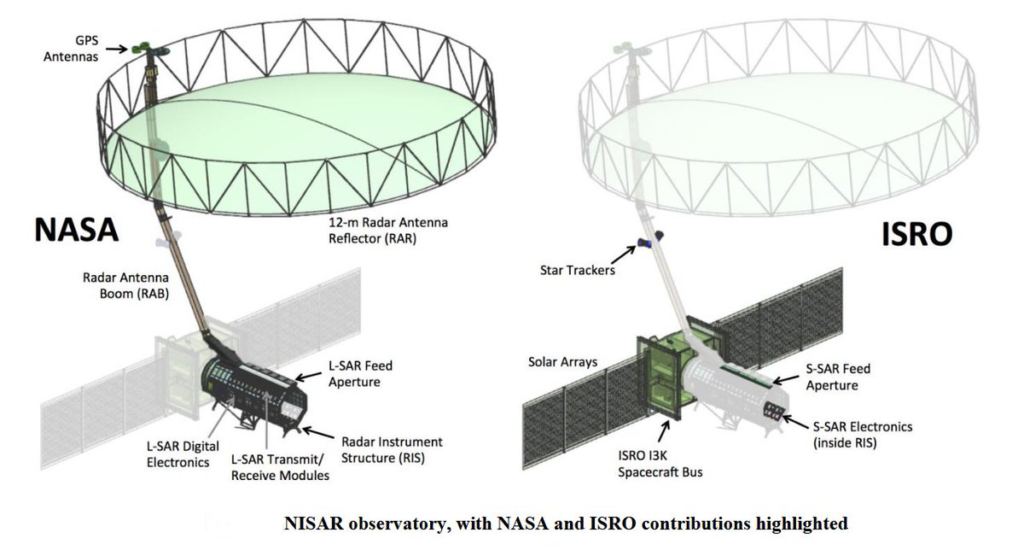
It could cover every point on Earth twice in 12 days duration. NISAR’s payload has an advanced radar system ever launched by NASA for a science mission which is the largest-ever radar space antenna drum-shaped and has a wire mesh reflector of 12 meters in diameter with an extended boom of 9 meters. The NISAR project has certainly brought NASA and ISRO very close and each of them has realised their relative strength and weakness. This would certainly help all future partnership projects. ISRO’s Geosynchronous Satellite Launch Vehicle Mark-II rocket will lift off in 2024 from Satish Dhawan Space Centre at Sriharikota to deliver NISAR into a near-polar Earth orbit. The mission objectives include agricultural monitoring and characterization, monitoring landslides and glacier movements, soil moisture, coastal disturbances, winds and natural hazards.
NISAR Mission Characteristics
| Orbit Altitude | 747 km |
| Orbit Inclination | 98.4° |
| Repeat Cycle | 12 days |
| Time of Nodal Crossing | 6 AM/ 6 PM |
| Orbit Control | < 500 m |
| Pointing Control | < 273 arcsec |
| Pointing | Left (south) |
| Baseline Mission Duration | 3 years |
| Consumables life | 5 years |
| Data and Product Access | Free & open |
| Wavelength | L-band: 24 cm S-band: 9 cm |
| SAR Resolution | 3–10 mtrs |
Promising Future
Global space industry value is estimated to be $350 billion and is likely to exceed $550 billion by 2025, whereas ISRO’s share is estimated at $7 billion and is just 2% of the global market. There is a huge opportunity for ISRO and the domestic space start-up ecosystem in the coming years and ISRO NASA bonhomie would certainly synergise the joint ventures in the coming decades. The NISAR and Artemis program will certainly help ISRO to accelerate its activities in the field of space exploration. ISRO is one agency that could achieve many milestones with the least investment and her experience will be useful for NASA to do more within her stipulated budget.
Image Courtesy: NASA
Disclaimer: The views and opinions expressed by the author do not necessarily reflect the views of the Government of India and Defence Research and Studies

